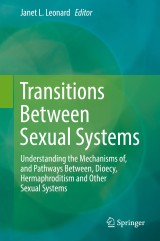Details

Transitions Between Sexual Systems
Understanding the Mechanisms of, and Pathways Between, Dioecy, Hermaphroditism and Other Sexual Systems|
213,99 € |
|
| Verlag: | Springer |
| Format: | |
| Veröffentl.: | 21.05.2019 |
| ISBN/EAN: | 9783319941394 |
| Sprache: | englisch |
Dieses eBook enthält ein Wasserzeichen.
Beschreibungen
<p>This book focuses on explaining the distribution of sexual systems (simultaneous hermaphroditism, sequential hermaphroditism, environmental sex determination,dioecy, androdioecy, etc.) among taxa, which remains a major challenge in evolutionary biology. Although significant advances have been made for angiosperms, there is not yet a theory that predicts the sexual system for the majority of animal taxa, and other taxa of plants also remain poorly understood. </p><p> The problem, particularly for animals, is that sexual systems can be very conservative, with whole phyla and classes being characterized by a single sexual system; for example essentially the whole phylum Platyhelminthes is simultaneously hermaphroditic, whereas the Insecta (Hexapoda) and the Tetrapoda among the vertebrates, are exclusively dioecious. Sex allocation theory on the other hand, suggests that sexual systems should be highly responsive to evolution, changing with population density, life span, patterns of resource availability, etc. The book provides an overview of the topic and then presents a series of chapters, each dealing with a taxon with substantial lability in sexual system in order to identify the factors associated with changes in sexual system in each case. By doing so, the authors reveal factors that have not been considered in formal theory but seem to have a major impact on transitions between sexual systems.</p><p>This book appeals to a wide readership in fields from zoology and evolutionary biology to botany.<br></p>
1. The Evolution of Sexual Systems in Animals.- 2. The Evolution of Sexual Systems in Animals.- 3. Evolutionary Transitions Between Combined and Separate Sexes.- 4. The Evolution of Uniparental Reproduction in Rhabditina Nematodes: Phylogenetic patterns, Developmental Causes, and Surprising Consequences.- 5. Polychaete Worms on the Brink Between Hermaphroditism and Separate Sexes.- 6. Sex Determining Mechanisms in Bivalves.- 7. Transitions in Sexual and Reproductive Strategies Among the Caenogastropoda.- 8. Hermaphrodites, Dwarf Males, and Females: Evolutionary Transitions of Sexual Systems in Barnacles.- 9. Life History Constraints Facilitate the Evolution of Androdiocy and Male Dwarfing.- 10. Sexual Systems in Shrimps (infraorder Caridea Dana, 1852), with Special Reference to the Historical Origin and Adaptive Value of Protandric Simultaneous Hermaphroditism.- 11. Environmental and Genetic Sex Determining Mechanisms in Fishes.- 12. Causes and Consequences of Evolutionary Transitions in the Level of Phenotypic Plasticity of Reptilian Sex Determination.
Janet L. Leonard is a Research Associate with the Institute of Marine Sciences, University of California-Santa Cruz and a Fellow of the California Academy of Sciences. She received her Ph.D. at the University of Wisconsin-Madison, served as an Instructor at the University of Maine-Orono, and was a postdoctoral Fellow at the University of Calgary, Alberta, Canada and at the Scripps Institution of Oceanography of the University of California-San Diego; followed by faculty appointments at the University of Oklahoma and at the Mark O. Hatfield Marine Science Center of Oregon State University. She has been a Visiting Erskine Fellow at the University of Canterbury, New Zealand, and President of the Western Society of Malacologists. Her research interests are in animal behavior, sexual selection, and invertebrate biology.
<p>This book focuses on explaining the distribution of sexual systems (simultaneous hermaphroditism, sequential hermaphroditism, environmental sex determination,dioecy, androdioecy, etc.) among taxa,which remains a major challenge in evolutionary biology. Although significant advances have been made for angiosperms, there is not yet a theory that predicts the sexual system for the majority of animal taxa, and other taxa of plants also remain poorly understood. </p><p>The problem, particularly for animals, is that sexual systems can be very conservative, with whole phyla and classes being characterized by a single sexual system; for example essentially the whole phylum Platyhelminthes is simultaneously hermaphroditic, whereas the Insecta (Hexapoda) and the Tetrapoda among the vertebrates, are exclusively dioecious. Sex allocation theory on the other hand, suggests that sexual systems should be highly responsive to evolution, changing with population density, life span, patterns of resource availability, etc. The book provides an overview of the topic and then presents a series of chapters, each dealing with a taxon with substantial lability in sexual system in order to identify the factors associated with changes in sexual system in each case. By doing so, the authors reveal factors that have not been considered in formal theory but seem to have a major impact on transitions between sexual systems.</p><p>This book appeals to a wide readership in fields from zoology and evolutionary biology to botany.</p>
<p>Provides a timely treatment of transitions between sexual systems in plants and animals</p><p>Identifies novel factors associated with changes in sexual systems</p><p>Explains sexual systems of different taxa</p>
<p><br></p><p><br></p>
Diese Produkte könnten Sie auch interessieren:

The Neural Crest and Neural Crest Cells in Vertebrate Development and Evolution

von: Brian K. Hall

149,79 €















